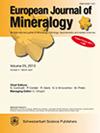Genetic model for the color anomalies at the termination of pegmatitic gem tourmaline crystals from the island of Elba, Italy
IF 1.7
3区 地球科学
Q2 MINERALOGY
引用次数: 0
Abstract
Abstract. Tourmaline crystals from the island of Elba commonly display a sharp transition to dark colors at the analogous termination due to the incorporation of Fe and/or Mn during the latest stages of crystallization in pegmatites. The formation of such color anomalies is related to a dramatic physicochemical change in the crystallization environment as a consequence of an opening of the geochemical system. However, mechanisms that may lead to the availability of Fe and/or Mn in the residual cavity fluids have been unclear. On the basis of chemical and spectroscopic investigations, combined with structural and paragenetic observations of the cavities, we propose a general genetic model in which, as a consequence of a pocket rupture event, chemical alteration of Fe- and Mn-rich minerals that formed early in the pegmatitic rock surrounding the cavities occurred through leaching processes, produced by the action of the highly reactive late-stage cavity fluids. Such processes were responsible for the release of Fe and Mn in the geochemical system, allowing the formation of the late-stage dark-colored terminations in the tourmaline crystals. In some cavities, a high availability of Mn and/or Fe determined the evolution of the crystals from an initial elbaite/fluor-elbaite composition to celleriite, foitite or schorl. This compositional evolution trend can be described by the following general chemical substitution: XNa+ + Y(Li1.5 + Al0.5)3+ + WF− ↔ X□ + 2Y(Fe,Mn)2+ + WOH−.意大利厄尔巴岛菱晶宝石电气石晶体末端颜色异常的遗传模型
摘要来自厄尔巴岛的碧玺晶体通常在类似的末端显示出一个急剧的深色过渡,这是由于在辉晶岩结晶的最后阶段,铁和/或锰的结合。这种颜色异常的形成与结晶环境的剧烈物理化学变化有关,这是地球化学系统开放的结果。然而,导致残余空腔流体中铁和/或锰可用性的机制尚不清楚。在化学和光谱研究的基础上,结合对空腔的结构和共生观察,我们提出了一个一般的成因模型,其中,作为一个袋状破裂事件的结果,在空腔周围的辉晶岩中形成的早期富铁和富锰矿物通过浸出过程发生了化学蚀变,这是由高活性的晚期空腔流体的作用产生的。这样的过程导致地球化学系统中铁和锰的释放,使得电气石晶体中晚期深色末端的形成成为可能。在一些空腔中,Mn和/或Fe的高可用性决定了晶体从最初的铁榴石/氟铁榴石组成向铁榴石、铁榴石或菱形石的演变。这种成分演变趋势可以用以下一般化学替换来描述:XNa+ + Y(Li1.5 + Al0.5)3+ + WF−↔X□+ 2Y(Fe,Mn)2+ + WOH−。
本文章由计算机程序翻译,如有差异,请以英文原文为准。
求助全文
约1分钟内获得全文
求助全文
来源期刊
CiteScore
2.80
自引率
9.50%
发文量
40
审稿时长
6-12 weeks
期刊介绍:
EJM was founded to reach a large audience on an international scale and also for achieving closer cooperation of European countries in the publication of scientific results. The founding societies have set themselves the task of publishing a journal of the highest standard open to all scientists performing mineralogical research in the widest sense of the term, all over the world. Contributions will therefore be published primarily in English.
EJM publishes original papers, review articles and letters dealing with the mineralogical sciences s.l., primarily mineralogy, petrology, geochemistry, crystallography and ore deposits, but also biomineralogy, environmental, applied and technical mineralogy. Nevertheless, papers in any related field, including cultural heritage, will be considered.

 求助内容:
求助内容: 应助结果提醒方式:
应助结果提醒方式:


